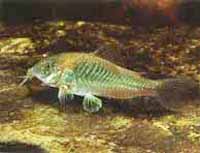Catfish and other 51 remarkable species discovered on Borneo
Scientists have discovered at least 52 new species of animals and plants on the southeast Asian island of Borneo over the last year, WWF International said Tuesday.

The new discoveries made between July 2005 and September 2006 include 30 fish species, such as a miniature fish, which is the world's second-smallest vertebrate, two tree frogs and several plant species, the Gland-based conservation organization said in a statement.
"The more we look the more we find," said Stuart Chapman, WWF International coordinator for the "Heart of Borneo," a 220,000-square-kilometer (85,000-square-mile) rain forest in the center of the island where several of the new species were found. "These discoveries reaffirm Borneo's position as one of the most important centers of biodiversity in the world."
Among the many creatures that were new to science were six Siamese fighting fish, whose unique colors and markings distinguish them from close relatives, and a catfish with protruding teeth and an adhesive belly with miniature suction cups enabling it to stick to smooth stones and maintain its position facing into the current of Indonesia's turbulent Kapuas River system.
The catfish, which can be identified by its pretty color pattern, is named glyptothorax exodon, a reference to the teeth that can be seen even when the creature's mouth is closed.
While those species were spotted in Indonesian waters, the 8.8 millimeter-long (0.35 inch-long) paedocypris micromegethes was discovered in Malaysia's slow-flowing blackwater streams and peat swamp forests shielded from light.
The creature, which gets its name from the Greek words for children and small in size, is tinier than all other vertebrae species except for its slightly more minuscule cousin, a 7.9-millimeter fish found on the Indonesian island of Sumatra, according to WWF.
The discoveries further highlight the need to conserve the habitat and species of Borneo, where the rain forest continues to be threatened with large areas of forest being destroyed for rubber, oil palm and pulp production, WWF said.
Much of Borneo, which also is home to the sultanate of Brunei, is covered by one of the world's last remaining rain forests. However, half of the forest cover has been lost due to widespread logging, down from 75 percent in the mid-1980s.
The new discoveries brings the total amount of species newly identified on the island to over 400 since 1996, according to WWF, known in North America as the World Wildlife Fund.
"The remote and inaccessible forests in the Heart of Borneo are one of the world's final frontiers for science, and many new species continue to be discovered here," said Chapman.
He added that the forests were also vital because they were the source the island's major rivers acting as a natural break to fires that have broken out in the lowlands this year.
Jane Smart, who heads the World Conservation Union's species program, also based in Gland, said that the discovery of 52 species within a year in Borneo was a "realistic" number given that scientists' guess there are about 15 million species on Earth. "There are still many more species that remain to be discovered there."
Borneo is particularly important for biodiversity because the island has a high number of endemic species, creatures which only occur in that one place, she told The Associated Press. "So if you wipe out a small area you're going to wipe out a lot of the species' habitat," she said, adding that once these creatures are destroyed, they are gone forever, reports AP.
"This is a real concern when forests are ripped out for rubber plantations or oil palm plantations," Smart said.
Subscribe to Pravda.Ru Telegram channel, Facebook, RSS!


